NAFTA and a New President for Mexico
Zip Dobyns
My recent trip to teach astrology in Mexico City provided a wonderful bonus in the form of timed birth charts for several of the men who were contenders to be the presidential candidate of the PRI, the Institutional Revolutionary Party. The PRI has controlled Mexican politics for the last 64 years, ever since it was founded in 1929. As in Japan, there have been many charges of corruption in high places, but the ruling Party has maintained its control of the Presidency. Japan has finally shaken its power structure by electing a Prime Minister backed by a coalition of smaller political parties. But Mexico expects the PRI to keep its control, at least for one more election which is scheduled for July 1994.
Mexican Presidents serve for six years and are not eligible for reelection. The outgoing President (in this case Carlos Salinas de Gortari) personally selects the man who will run for the office in the next election. The selection is scheduled to be announced before the next election. In 1993, the process was complicated by the impending passage (or defeat) of NAFTA, the free trade agreement with the U.S. and Canada, and by a planned visit from Vice President Al Gore. Salinas could not wait until after Gore’s visit as it could invite rumors that the U.S. influenced his choice. Salinas did wait until after the NAFTA vote in the U.S. House of Representatives. He had pushed hard to get NAFTA approved, putting much of his prestige on the line. Once it was successfully (from his point of view) settled, he announced his choice of Mexico’s next president — Luis Donaldo Colosio.
My workshops in Mexico City focused on the use of secondary progressions in future projections for individuals or other entities, and on mundane astrology. Naturally, we spent most of our time on charts relevant to Mexico which were provided by the local astrologer who acted as my interpreter. Luis had managed to get the birth certificates of the three men who were considered front runners in the choice to be made by President Salinas. Pedro Aspe was considered the least likely choice since as Treasurer he had implemented some very unpopular new tax laws. He was born on July 7, 1950 at 7:45 A.M. CST in Mexico City. The astrologers attending the workshop agreed that he was probably more fiscally responsible than the other two men but could not be elected. Since his chart had few strong progressed aspects, the consensus seemed reasonable.
The majority in the class felt that Manuel Camacho Solis was the most likely choice. Like Aspe and Salinas, he was born in Mexico City, and he was a lifetime friend of Salinas. Solis was born on March 30, 1946 at 9:20 P.M. CST. But, like Aspe, he had few aspects to his angles. As with Aspe, I did not think that his chart showed enough strength to become the head of the country even though he had been a moderately popular mayor of Mexico City.
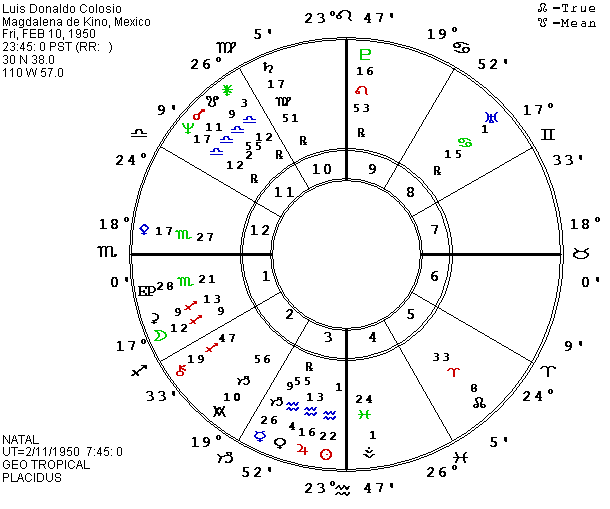
Colosio’s chart was clearly the most powerful even though his background made him seem less likely to be the choice. He was born in Magdalena de Kino in Sonora which borders on the U.S., and Mexico’s politics have always been controlled by natives of Mexico City. He was the son of a rancher so less a part of the power elite. But he also had some facts in his favor. He was the only one of the three possible candidates who had actually won a national election rather than occupying appointed positions. He had been the head of the PRI for over three years and had formed some strong political connections. He had also been involved in environmental and social programs which added to his popularity. And he had shown great skill in building political consensus. As one commentator put the matter: Colosio was picked because he could win the election.
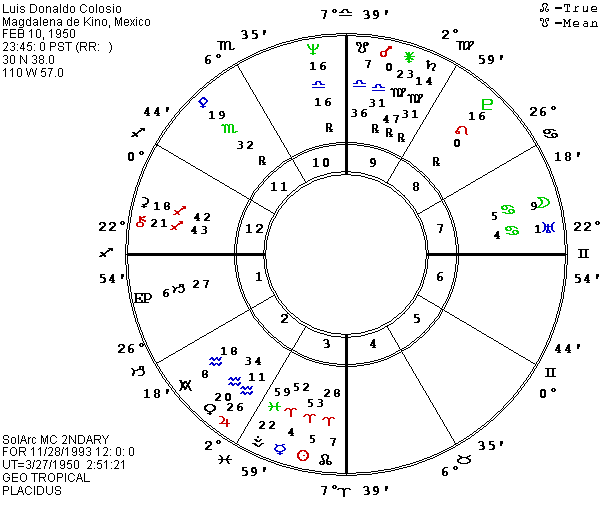
Colosio’s chart supports this comment. When Salinas made his choice, Colosio had his P MC on P south lunar node suggesting both a lesson in handling power and something to give the world through the use of executive power. P local MC in Mexico City was trine P Venus and will reach the trine to natal Sun in December 1993. P Ascendant was sextile the Sun and square P Vesta. P local Ascendant was square the lunar nodes and semisextile Ceres and the local East Point. It is quite common to have conflict aspects when we take on a difficult project such as trying to lead a country in the world’s present state of turmoil. It is a lack of aspects which make it unlikely that anything important is going to develop. P Mercury had just caught up to P Sun to fit the media attention which followed the announcement that Colosio was the President’s choice. P local Antivertex was on P Jupiter. P East Point was trine the local natal MC, square the P Sun, and just starting squares to the P lunar nodes.
There were also angle aspects to important midpoints. P local East Point was conjunct the Sun/Moon midpoint and P Antivertex was conjunct the Sun/Mercury midpoint. Note that the Sun and Mercury rule the two signs in the tenth house of the executive. P Venus will conjunct the Sun by the elections in July 1994 and most of the listed aspects will still be in orb. P Moon by that time will be in 16 Cancer with a semisextile to Pluto, square to Neptune, trine to Pallas (just above his Ascendant, which fits Colosio’s political career), a quincunx to Jupiter, a trioctile to Vesta, and sometime in July, a sextile to Saturn. When the power in his chart is compared to the other two possible candidates, there is really no comparison. Presumably, Salinas does not know any astrology but he knew which of his friends could win the election.
Colosio’s main opponent will be Cuauhtemoc Cardenas, the candidate of the PRD (Party of the Democratic Revolution). The PRD is more socialistic than the PRI, and it has been gaining ground in recent years as the economic conditions of many people have worsened, but most observers expect the PRI to maintain its hold on the top government positions. Cardenas was born in Mexico City on May 1, 1934 but I do not have his exact time of birth. It may have been near 6 P.M., but I hope to get a more precise figure by the time of the election next summer. Without a birth time, we can see that he has a strong will with factors in Aries and Taurus including Sun conjunct Mars in Taurus. He also is idealistic with Moon in Sagittarius and Venus in Pisces.
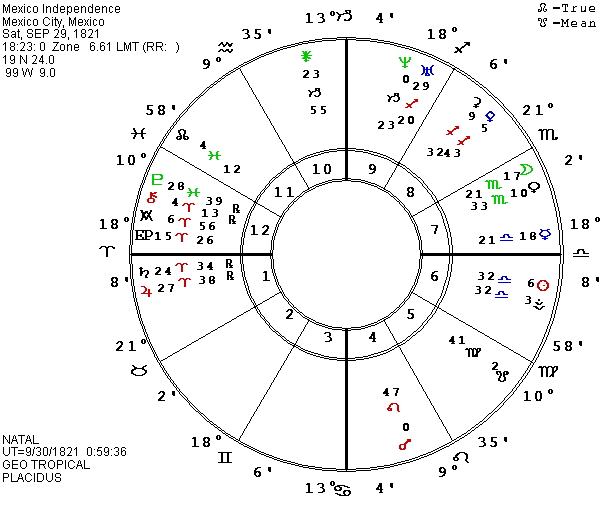
In addition to the birth data of the political candidates, my Mexican interpreter Luis has been using a chart for Mexico’s independence and one for its constitution. Luis says that the charts have proved reliable, and the aspects for the NAFTA vote certainly supported this period as a time of major change for the country. The Independence chart is for September 29, 1821 at 18:23 LMT in Mexico City. Saturn and Jupiter were rising in Aries with Mercury on the Descendant. As readers will remember, our previous conjunction of Uranus and Neptune occurred in that year, and many countries were rebelling against former masters. In this Mexico chart, Uranus is just coming to Neptune in the ninth house and they trine the rising Jupiter and Saturn but square the Vesta-Sun conjunction in the sixth house and Pluto in the twelfth house. Mars has just entered Leo in the fourth house (the land and the people) to form a grand trine in fire signs and water houses including Pallas and Ceres in the eighth house and Pluto in late Pisces with Chiron and the Antivertex in early Aries. Mars also sextiles Vesta and the Sun. Venus and the Moon are widely conjunct in Scorpio sextile the MC. The lunar nodes in Pisces-Virgo square Pallas-Ceres but are sextile-trine Uranus-Neptune.
As usual, the picture is very mixed. There is considerable harmony, including the grand fire trine and a grand earth trine when P Jupiter moved into early Taurus: enough fire and earth steam-roller potential to have had more impact on the world than we have seen so far. Perhaps they were partly so over-shadowed by their aggressive northern neighbor that they were not able to mobilize their full potential. The power of the wealthy elite may also have kept the majority of the people close to bare survival, unable to develop their skills. The constant pressure of over-population, thanks in part to the control of Roman Catholicism, was probably another factor which inhibited development. The lower status of women and of a sizable population of native peoples probably limited their educational opportunities and contributed to a reduced sense of confidence and effectiveness. The climate and the culture are always part of the picture. But in light of the power of Rome at the beginning of the Christian era and the brilliant intellectual accomplishments of the early Greeks, no one could put the major blame on the climate. I haven’t worked with the chart (as I have with several of the U.S. horoscopes) so cannot say from personal experience whether it is reliable. If it is, the future potential of Mexico certainly looks hopeful, though the inhibiting factors just listed will not make it easy.
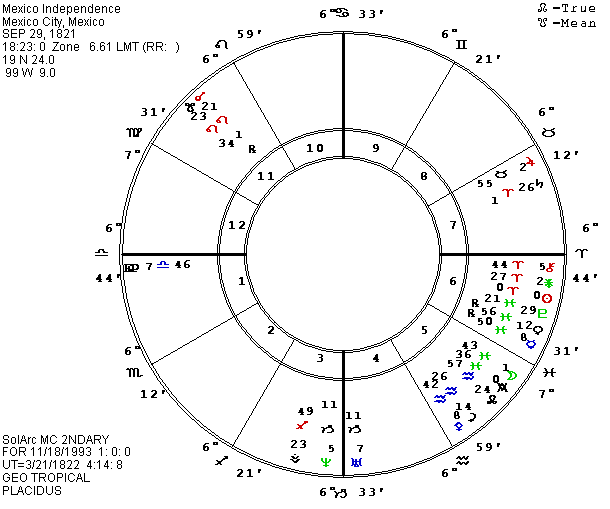
The current progressions of this chart are dramatic, with P Sun just entering Aries the month that NAFTA was passed by the U.S. Congress. P Sun has been conjunct Pluto for over two years and square Uranus and Neptune more recently as President Salinas has lowered tariffs to open up the Mexican market and has sold some 80% of the government businesses to private owners. The results have been helpful to the wealthy elite, but the effect on ordinary people has often been disastrous. One artist I spoke with while in Mexico City in November told me that up to a few years ago, there were 20 factories in Mexico which made pottery. All but two have now failed as the country has been flooded by cheap Chinese imports. A report on U.S. public radio said that out of the population which was formerly above the poverty line, 25% are now below that line, and the number of billionaires has more than doubled. NAFTA will probably continue the same trend as big U.S. companies rush in to replace local mom and pop operations. Where 20 little suppliers used to service a hotel, one international company will take over. Price Club and Wal-Mart are already in Mexico City and fast food franchises are multiplying around the countryside. I talked to a Canadian oil man on the plane going down and he was eager to bring in their efficiency and displace the local inefficiency. The U.S. banks are salivating to get in to challenge the local banks which have charged high interest and offered poor service. As is always the case with change, some will benefit and some will lose. But the problem of unemployment is worldwide and scary. When a machine and one person can do the work of 100, how will the 100 buy the products of the machine?
Other progressed aspects in this Independence chart include P Ascendant on the Sun and the Vertex (which is opposite the Antivertex and is like another Descendant in the chart). P East Point was forming the same aspects as Salinas implemented his radical changes in the Mexican economy. P Ascendant is also square P Uranus and octile P Mars, additional keys to the major changes in relationships with foreign countries and the effect on the people. P MC holds similar aspects, reinforcing the picture. It is square the Sun and the Antivertex axis and P Chiron, octile P Mars, and opposite P Uranus. P Venus was octile Jupiter, P Mercury was square Ceres, and P Moon was just ending a quincunx to Mars when NAFTA went through. There are some harmony aspects including P Vesta trine Saturn and P Jupiter trine the south lunar node, but I’m afraid that they again favor foreign countries and the local power elite.
I have a small number of asteroids calculated back to the 1700s, and there are several with interesting aspects in this Mexican Independence chart. P Henry (for Perot) was in eight Taurus square P Pallas, quincunx P East Point, and applying to a quincunx to natal Ceres and P George (for Bush) in 9 Sagittarius. P Rockefellia (for the elite of oil and banks) was in 29 Virgo opposite Pluto and P Sun and quincunx natal Henry in 29 Aries. P America and P Industria were conjunct in eight Cancer, square P East Point, with P Ascendant moving into a square to them and P MC moving to conjunct them in 1994. P Washingtonia was at 14 Taurus 26 octile P Pluto and P Sun and trioctile P Rockefellia. P Damocles (the sword hanging above the head) was on P Moon quincunx natal Mars. We do not have an asteroid specifically named for Mexico, but Hidalgo comes the closest. The astronomer who discovered it wanted to thank the Mexican government for their assistance and asked what name they would like given to the asteroid. They chose Hidalgo, the name of the Priest who led their first (though unsuccessful) rebellion against Spain. Natal Hidalgo in this chart was at 3 Capricorn 6. P Hidalgo when NAFTA was signed was in 28 Capricorn 25 sextile Pluto and trine P Rockefellia. The aspects again seem to support the wealthy elite. We will see what happens when P Hidalgo reaches the opposition to natal Mars.
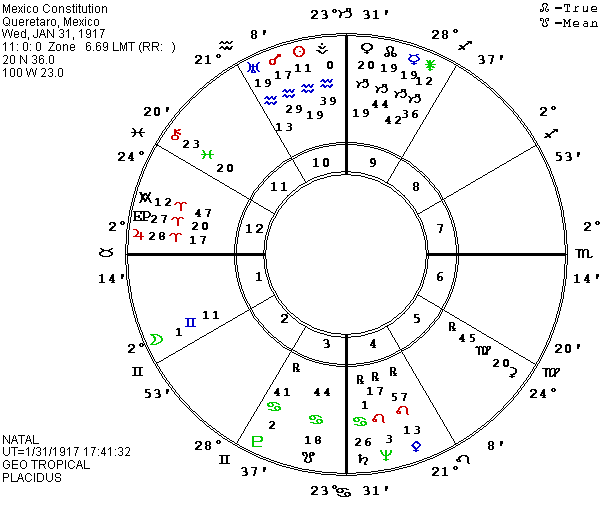
The other chart being used by Luis is for the current constitution. It is set for January 31, 1917 at 11 A.M. in Queretaro, Mexico. The initial impression one gets from the chart is of constant change, and Luis says that this is accurate. The constitution is constantly being revised. There is a strong emphasis on religion in the chart with Jupiter on the East Point and Ascendant, Neptune in the fourth house of the people, and a loaded ninth house. But there is also a strong emphasis on freedom with the Aries and Aquarius factors, but the potential for conflict with the conservative Capricorn and Cancer. The Mexicans generally love their families and want children. There are also indications of major tensions with P Saturn conjunct the IC for years and natal Mars just over one degree from the local MC in Mexico City, the government headquarters.
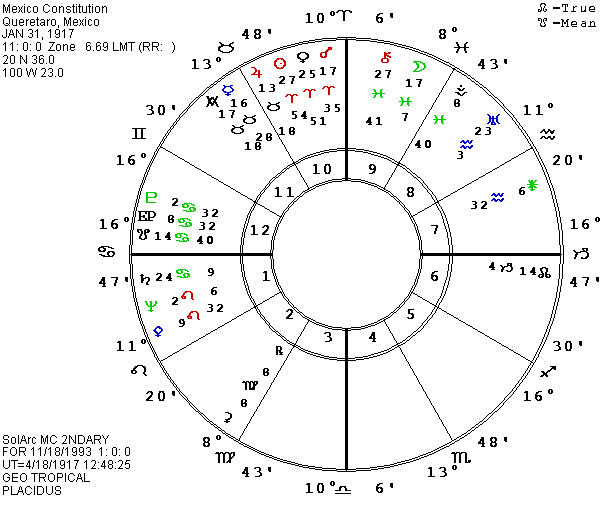
When NAFTA was signed, P Ascendant was at the midpoint of natal and P south lunar nodes, pointing to years of tension and lessons involving relationships and security issues. Since the third house includes neighbors in its meanings, we can assume that some of the tensions are certainly with the U.S. P Ascendant was also opposite P Hidalgo for the changes coming to the country. P local (Mexico City) MC was conjunct the natal Ascendant and square Neptune, pointing to changes involving the executive branch of the government and the land and people. P L MC was also quincunx P Henry which was retrograding in 2 Libra 52. But many people are hoping that NAFTA will bring them more jobs. P Sun is on Jupiter and P Venus is approaching the East Point. P Moon is semisextile natal and P Mars and sextile P Antivertex and P Mercury. The latter factors are also moving into trines to the ninth house factors but they square natal Mars and will square Uranus. I keep wondering whether the job deficit will be bad enough to invite revolution when transiting Uranus reaches its own sign. We will need to test the chart against past events and watch it during future ones to see whether it is reliable.
For mundane students who would like to do more work on NAFTA, Luis also gave me the dates, times, and places when the original negotiations were completed and when they were signed by Bush administration officials. The agreement was finalized (subject to the changes added later by Clinton) on August 12, 1992 at 0:40 A.M. EDT in Washington, DC. The agreement was signed in San Antonio, TX on October 7, 1992 at 15:32 CDT. The crucial U.S. vote was by the House of Representatives in the evening on November 17, 1993 in Washington, DC. Maybe one of our readers was watching CNN and knows the time? There was no question about the Senate passing the agreement and the President signing it. The charts for the Mexican Constitution and Independence are progressed to November 18 since our computer program uses UT to calculate progressions and in England, it was already the 18th.
Some of the world’s problems today are due to over-population, some to greed for money, territory, power etc. The empathy we are supposed to be developing in the Piscean Age seems sadly remote.